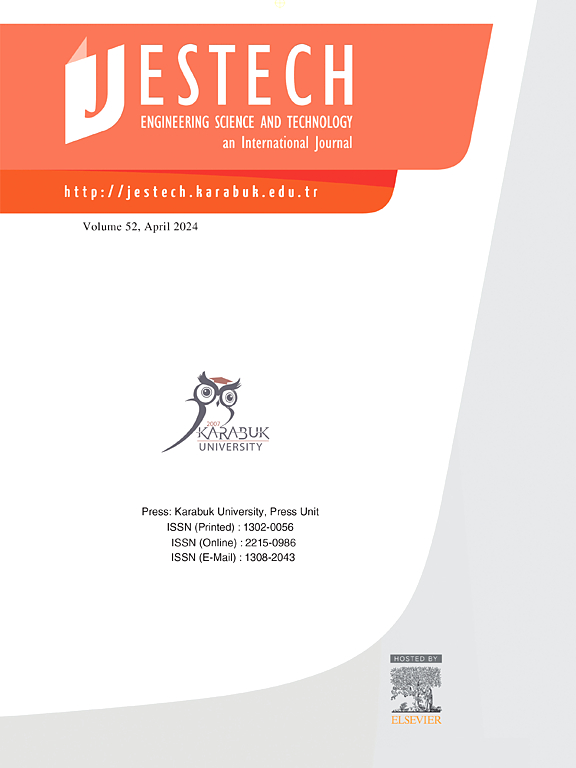A novel model for higher performance object detection with deep channel attention super resolution
IF 5.1
2区 工程技术
Q1 ENGINEERING, MULTIDISCIPLINARY
Engineering Science and Technology-An International Journal-Jestech
Pub Date : 2025-02-25
DOI:10.1016/j.jestch.2025.102003
引用次数: 0
Abstract
With the introduction of deep learning methods, target object detection studies have gained momentum and started to be used in many areas. In recent years, various problems related to training the model with appropriate images and improving the current image quality to detect the target object more successfully have been discussed. In the light of these discussions, the identification of dangerous objects, which is one of the most important areas of object detection, is quite remarkable. For this reason, within the scope of study, a new dataset called DMGDATA-mini was prepared to detect dangerous objects and presented to the public. By using the data in the training of the You Only Look Once (YOLO) model of YOLOv5, it was ensured that the model successfully detected the object. In order to increase the object detection success and observe the results, popular Super Resolution (SR) algorithms and the Deep Channel Attention Super Resolution (DCASR) algorithm developed by us were integrated into the structure and the effect of SR algorithms on object detection was observed. It was determined with the Peak Signal-to-Noise Ratio (PSNR) metric that the developed DCASR algorithm performs better image enhancement than all SR algorithms in the study. Also, YOLOv5 and YOLOv5 + SR models were also compared. Thanks to the improved DCASR model, a 9.9 % increase in object detection success was observed. It was observed that SR algorithms have a positive effect on performance in general.
一种基于深度通道关注超分辨率的高性能目标检测新模型
随着深度学习方法的引入,目标物体检测研究获得了发展势头,并开始在许多领域得到应用。近年来,人们讨论了如何用合适的图像训练模型,提高当前图像质量以更成功地检测目标物体的各种问题。根据这些讨论,危险物体的识别是物体检测中最重要的领域之一,这是非常了不起的。因此,在研究范围内,准备了一个名为DMGDATA-mini的新数据集,用于检测危险物体并向公众展示。通过将这些数据用于YOLOv5的You Only Look Once (YOLO)模型的训练,确保模型成功检测到目标。为了提高目标检测成功率和观察结果,将目前流行的超分辨率(SR)算法和我们开发的深通道注意超分辨率(DCASR)算法集成到该结构中,观察SR算法对目标检测的影响。通过峰值信噪比(PSNR)指标确定,所开发的DCASR算法比研究中的所有SR算法具有更好的图像增强效果。并对YOLOv5和YOLOv5 + SR模型进行了比较。由于改进的DCASR模型,目标检测成功率提高了9.9%。结果表明,SR算法总体上对性能有积极的影响。
本文章由计算机程序翻译,如有差异,请以英文原文为准。
求助全文
约1分钟内获得全文
求助全文
来源期刊

Engineering Science and Technology-An International Journal-Jestech
Materials Science-Electronic, Optical and Magnetic Materials
CiteScore
11.20
自引率
3.50%
发文量
153
审稿时长
22 days
期刊介绍:
Engineering Science and Technology, an International Journal (JESTECH) (formerly Technology), a peer-reviewed quarterly engineering journal, publishes both theoretical and experimental high quality papers of permanent interest, not previously published in journals, in the field of engineering and applied science which aims to promote the theory and practice of technology and engineering. In addition to peer-reviewed original research papers, the Editorial Board welcomes original research reports, state-of-the-art reviews and communications in the broadly defined field of engineering science and technology.
The scope of JESTECH includes a wide spectrum of subjects including:
-Electrical/Electronics and Computer Engineering (Biomedical Engineering and Instrumentation; Coding, Cryptography, and Information Protection; Communications, Networks, Mobile Computing and Distributed Systems; Compilers and Operating Systems; Computer Architecture, Parallel Processing, and Dependability; Computer Vision and Robotics; Control Theory; Electromagnetic Waves, Microwave Techniques and Antennas; Embedded Systems; Integrated Circuits, VLSI Design, Testing, and CAD; Microelectromechanical Systems; Microelectronics, and Electronic Devices and Circuits; Power, Energy and Energy Conversion Systems; Signal, Image, and Speech Processing)
-Mechanical and Civil Engineering (Automotive Technologies; Biomechanics; Construction Materials; Design and Manufacturing; Dynamics and Control; Energy Generation, Utilization, Conversion, and Storage; Fluid Mechanics and Hydraulics; Heat and Mass Transfer; Micro-Nano Sciences; Renewable and Sustainable Energy Technologies; Robotics and Mechatronics; Solid Mechanics and Structure; Thermal Sciences)
-Metallurgical and Materials Engineering (Advanced Materials Science; Biomaterials; Ceramic and Inorgnanic Materials; Electronic-Magnetic Materials; Energy and Environment; Materials Characterizastion; Metallurgy; Polymers and Nanocomposites)
 求助内容:
求助内容: 应助结果提醒方式:
应助结果提醒方式:


